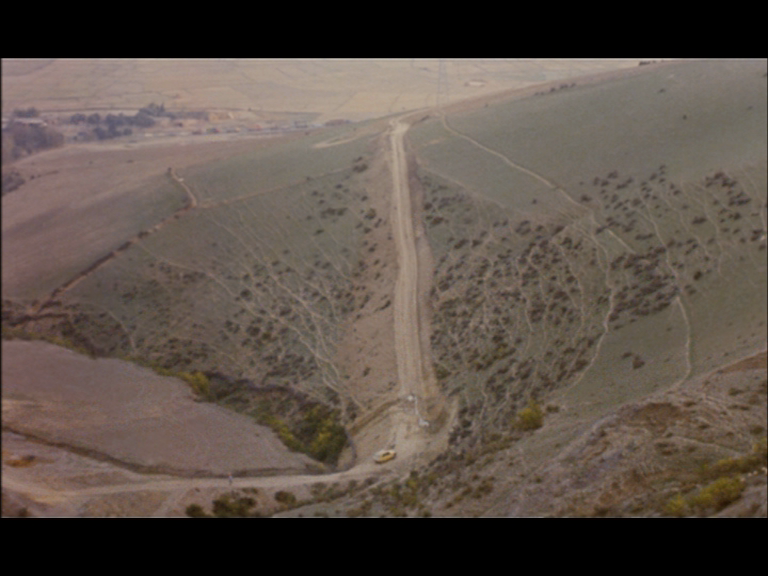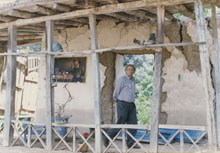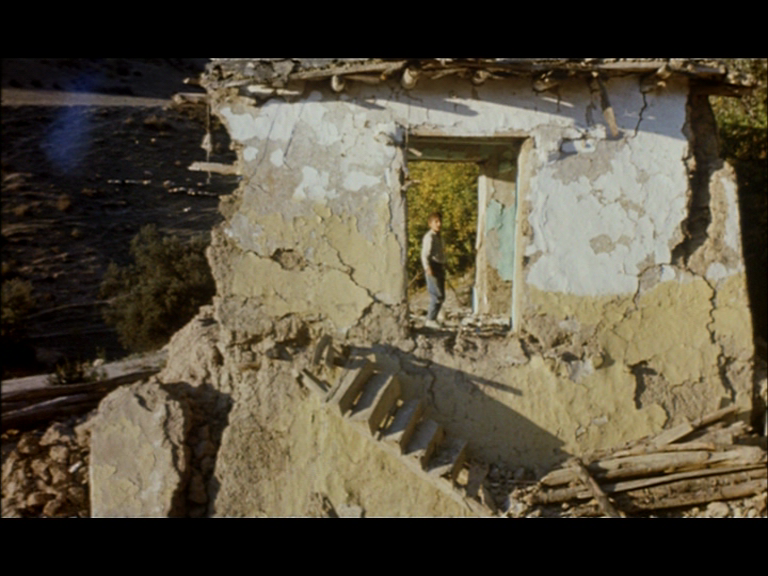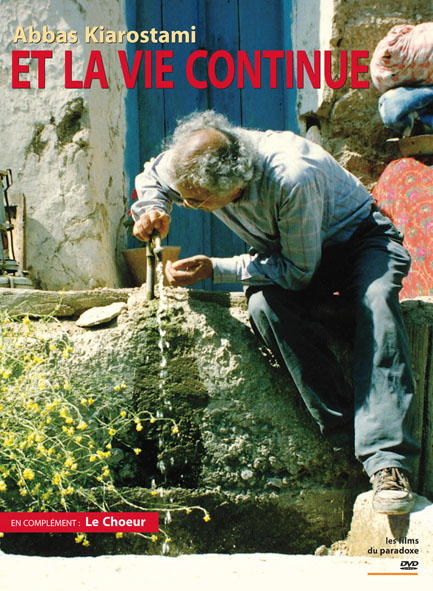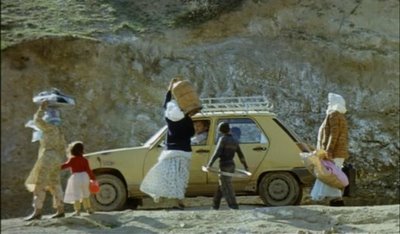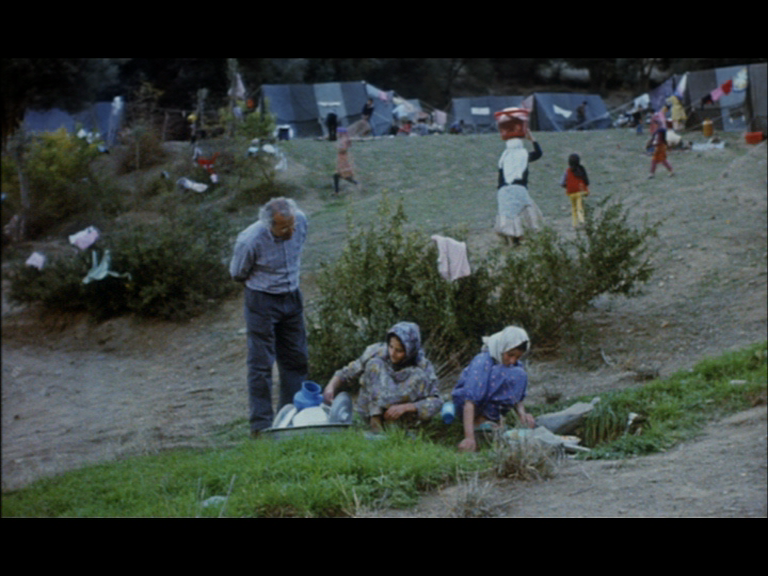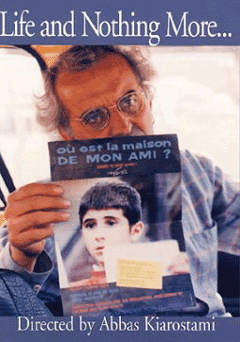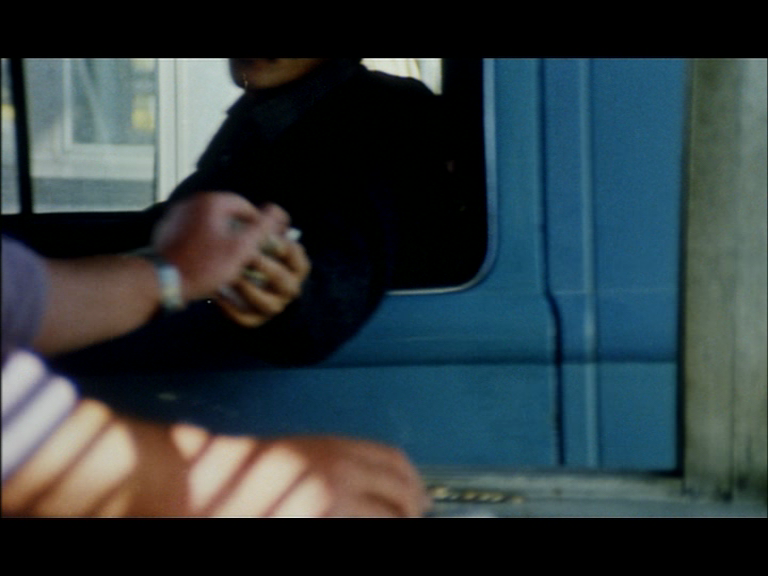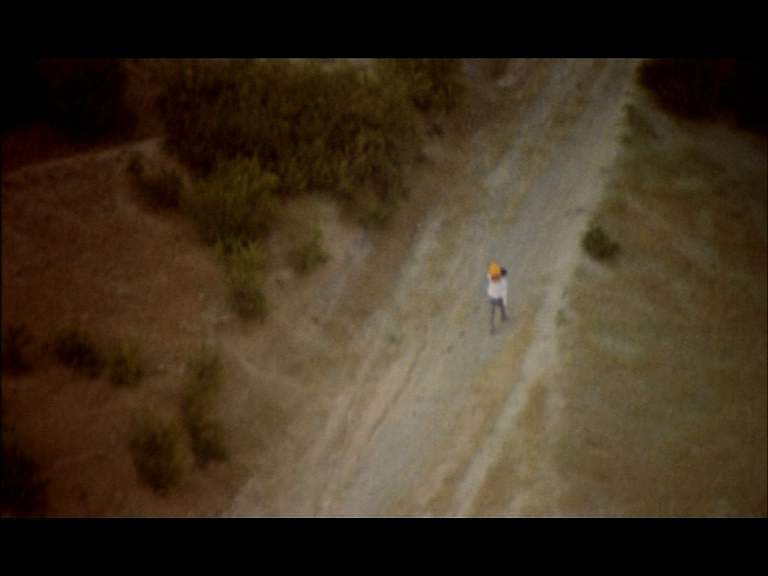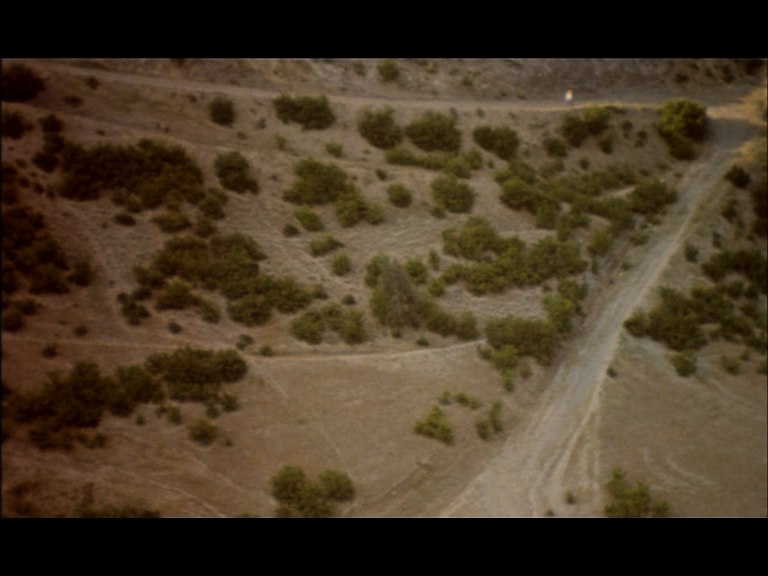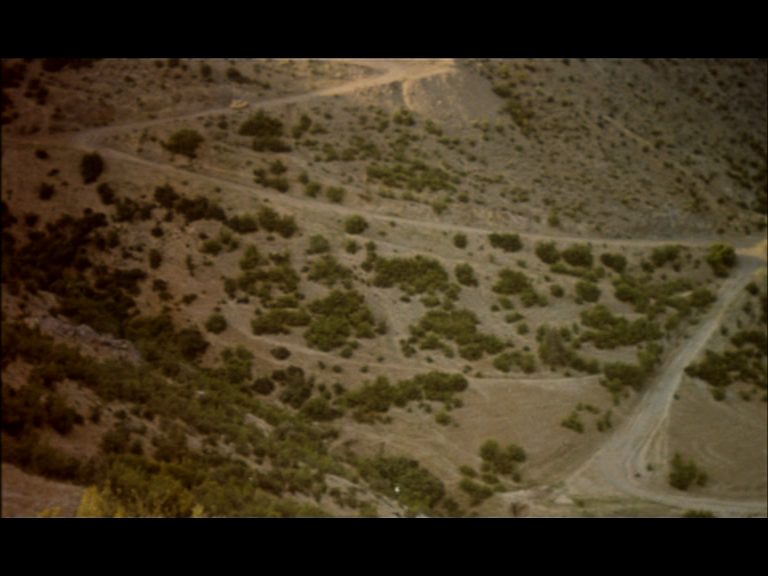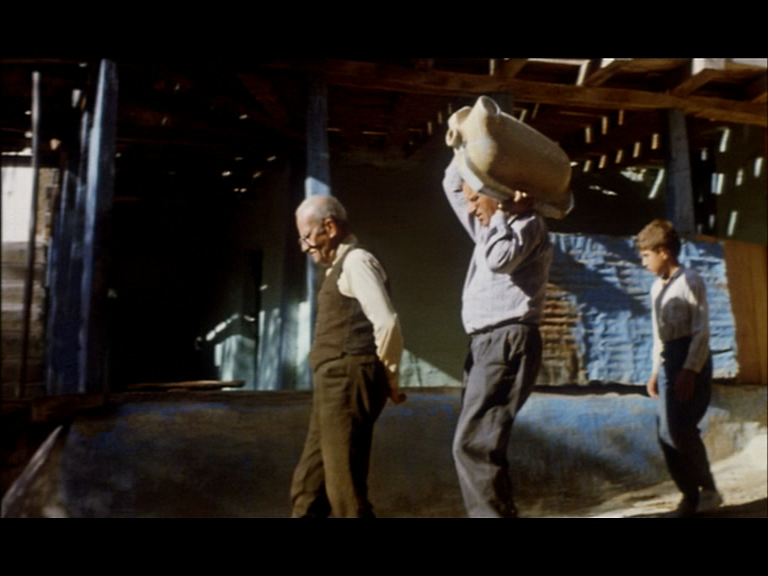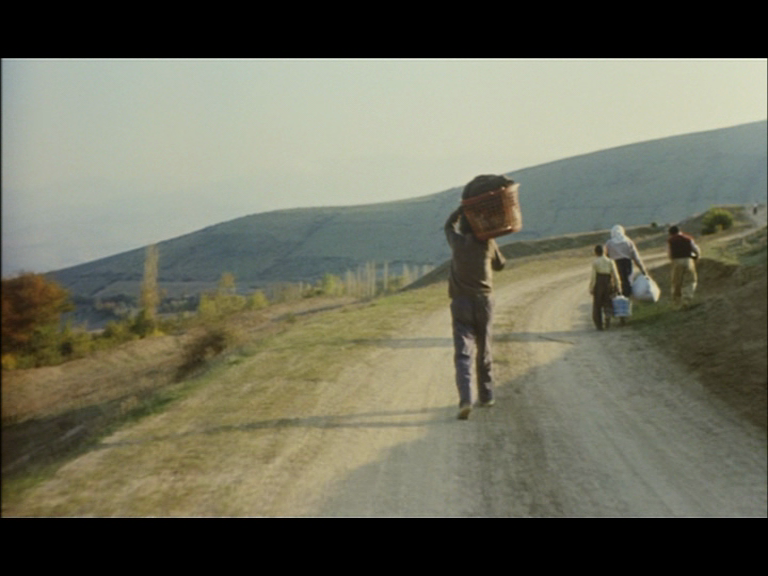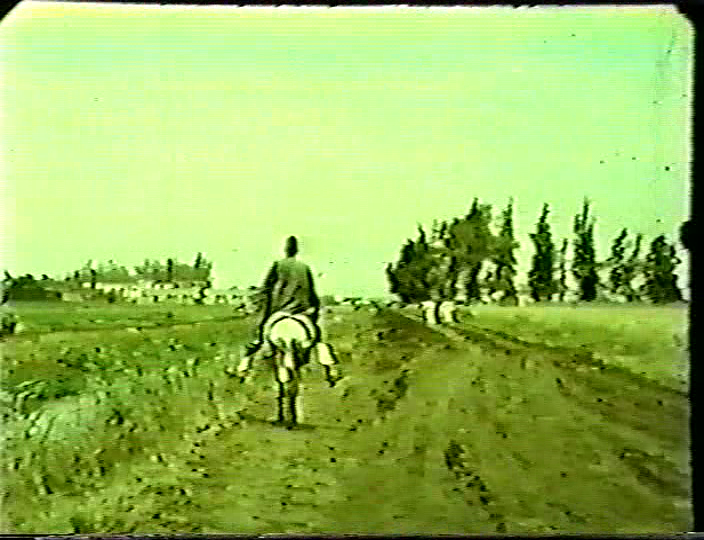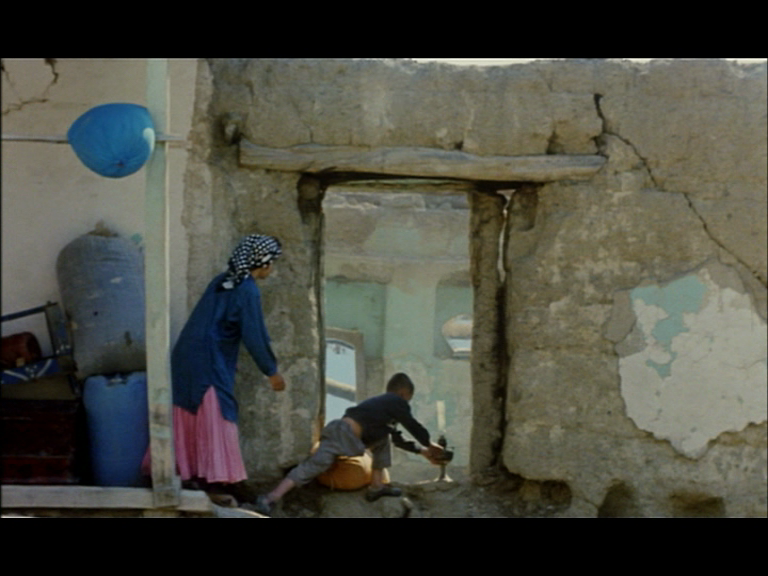From the October 23, 1992 Chicago Reader. This represents my very first attempt to write about Kiarostami’s cinema in a longer review, while I was still beginning to get acquainted with it, and I very much regret my serious underestimation of Where is The Friend’s House? (whose title I and others also got wrong at the time). On the matter of Tati and Kiarostami, Kiarostami has always denied having heard of him whenever I’ve brought up the name, but his former collaborator Amir Naderi affirmed that Kiarostami certainly knew who he was, having been present at the Children’s Film Festival in Tehran when Tati headed the jury there in the mid-1970s (and in fact, I was reminded by Amir’s remarks that Richard Combs, my boss at the time in London, served on the same jury). In fact, I’ve learned from Ehsan Khoshbakht that this festival was sponsored by Kanun, where Kiarostami was employed at the time. — J.R.
AND LIFE GOES ON . . . (LIFE AND NOTHING MORE)
**** (Masterpiece)
Directed and written by Abbas Kiarostami
With Farhad Kheradmand and Pooya Pievar.
It’s fascinating to consider the ideological factors that influence how film canons are formed, especially when it comes to films that depict unfamiliar cultures. Without thinking much about it, we tend to prefer American movies that suggest either that foreigners are just like us (the liberal approach, as in Samuel Fuller’s China Gate, in which Angie Dickinson is cast as a Eurasian) or that they’re devils from another planet (consider the xenophobic and racist depiction of Vietcong soldiers in Michael Cimino’s The Deer Hunter). The possibility that they might be neither is often more than the media can handle, with the unfortunate consequence that movies are less likely to make it big when they depict foreigners as complex beings who are not carbon copies of ourselves — movies, in short, that are human in their approach but not necessarily idealistic or sentimental or bourgeois humanist. When it comes to foreign movies that depict their own cultures, the same rules apply but with even greater force.
As one index of how ill equipped most of us are to deal with films made in Iran, consider the kind of treatment Iranian or proto-Iranian characters have received in American movies — and it only got worse after the Islamic revolution and the seizure of American hostages in Tehran in 1979, in pictures like Raiders of the Lost Ark. If that’s all we’re capable of comprehending in an American movie, how much can we hope to understand in an Iranian film?
Not surprisingly, we’re often insecure even about the most basic elements of Iranian cinema, such as titles and locations. Consider the title of Abbas Kiarostami’s latest feature — which deservedly won the Rossellini prize at the last Cannes film festival and is in many ways the most beautiful and powerful Iranian film I’ve seen (it’s showing Sunday at the Film Center). It’s being called Et la vie continue in France and has been given an English title here that’s a precise translation of that, yet I’m told that a more accurate translation of the Iranian is Life and Nothing More. But because the latter title might be confused with Bertrand Tavernier’s Life and Nothing But, we’re stuck with the more sentimental and less accurate And Life Goes On. . . .
I first saw Kiarostami’s new feature at the Locarno film festival last August; to me it was far and away the most exciting thing there. Most of the Locarno festival’s main films were projected on an enormous outdoor screen in the town square where thousands of people watched at once. Kiarostami’s film was not one of them, and festival director Marco Muller told me that the only reason was that Kiarostami himself feared the film wouldn’t work on such a grand scale. (I strongly suspect he was wrong, but how can one be sure?)
When I saw Kiarostami’s film a second time — at a retrospective of recent Iranian cinema at the Toronto Festival of Festivals last month — the festival program described it as a film dealing with the aftermath of an earthquake in northern Iraq. The earthquake in question — responsible for the deaths of over 50,000 people in 1990 — actually took place in northern Iran. Though the difference of one letter could perhaps be excused as a simple typo, I think it points to a general misunderstanding — consider that during the recent gulf war Iranians in this country were widely confused with emigres from Iraq, despite the fact that the two countries speak different languages and spent the better part of the last decade at war with each other.
My knowledge of recent Iranian cinema — for much of which I’m indebted to Mehrnaz Saeed-Vafa, an Iranian filmmaker and teacher now based in Chicago — is for the most part restricted to two highly interesting and talented artists, Kiarostami and Mohsen Makhmalbaf. The two Makhmalbaf features I’ve seen, The Peddler (1987) and Marriage of the Blessed (1989), were both screened at the Film Center’s Iranian retrospective two years ago. The present retrospective includes another 1989 Makhmalbaf film, The Cyclist (shown earlier this month), which I haven’t seen, as well as the three Kiarostami films I have, Where Is My Friend’s Home? (1988), Close-Up (1990), and And Life Goes On. . . .
There are a few basic differences between these two filmmakers. Kiarostami, born in 1940, has been active as a filmmaker since the reign of the shah — although it could be argued that he’s emerged as a major figure only quite recently, well after the revolution. Makhmalbaf, born a dozen years later, was a political prisoner of the shah for five years, from 1974 to 1979; he became a filmmaker only after his release, and has made ten features since 1981. In a very real sense Makhmalbaf qualifies as a child of the fundamentalist revolution, though most recently he’s been an unruly and unpredictable child, not a docile pupil. His three most recent features, Time of Love, Nights on Zayandeh Road, and Once Upon a Time, Cinema — none of which has been shown yet in the United States — have all been banned in Iran, apparently because he treats women in a way deemed unacceptable by the Islamic clergy and censors. I don’t know anything about the second of these films, but the first deals with the adulterous relationship between a married woman and a cabdriver, and the third depicts the early history of Iranian cinema and, according to Samuel Fuller (who, as head of the jury at the Taormina film festival last summer, awarded this film first prize), includes a rather barbed treatment of harems. To all appearances, the same filmmaker who published a book shortly after the revolution in which he called for women in the theater to be given only the most limited roles is today making some waves.
On the basis of this information, and having seen the earlier The Peddler and Marriage of the Blessed, I would call Makhmalbaf the manic, hyper-eclectic Scorsese of the new Iranian cinema — with, as Saeed-Vafa suggests, occasional echoes of Hitchcock. The calmer, more studious and philosophical Kiarostami comes closer to an Ozu or a Tati. Both Iranians mix fiction and nonfiction in a number of fascinating ways that make them natural inheritors of a tradition closely associated with Roberto Rossellini, but there the stylistic affinity ends. (Strangely, in Kiarostami’s Close-Up the two filmmakers come together: This film follows the misadventures of an actual unemployed film buff who impersonated Makhmalbaf in order to worm his way into the good graces of a wealthy family, claiming he wanted to enlist them as actors in a new feature. Kiarostami not only filmed the trial and persuaded both the impersonator and the family to restage key events, he also enlisted Makhmalbaf to meet his impersonator expressly for the purposes of the film, which led to the man’s release from prison.)
Given Scorsese’s relative commercial success and Ozu’s and Tati’s relatively uncommercial status today, one might assume from the above description that Makhmalbaf rather than Kiarostami would be favored in the West, but it hasn’t worked out that way. Recently And Life Goes On . . . became the first Iranian film ever shown at the New York film festival, and it’s lately been featured in the two leading French film magazines, on the cover of Positif and as the “still of the month” in Cahiers du Cinéma. (The French also received Close-Up enthusiastically, and Kiarostami notes in Positif that this popularity abroad has led to some difficulties for him in Iran: he’s been criticized for using a French car, a French poster advertising Where Is My Friend’s Home?, and a Vivaldi string concerto in And Life Goes On . . . , all of which have been described as pandering to Western tastes.)
On the other hand, it’s far from mysterious that Makhmalbaf has not yet been accorded as much attention in the United States and Europe. Scorsese’s eclectic style succeeds commercially in the West largely because the ideological content of his movies is usually far from progressive. (When it has been progressive, as in The King of Comedy, audiences haven’t turned out as they have for Taxi Driver, Raging Bull, GoodFellas, and Cape Fear.) Makhmalbaf may use a similarly eclectic style to explore the contradictions and conflicts of Islamic fundamentalism, but his ideology, reactionary or progressive, has little to do with Western audiences.
It’s hard to say with certainty who Kiarostami’s influences are — in interviews his statements sometimes contradict one another — but some of the parallels between And Life Goes On . . . and the work of Tati are worth noting. Both filmmakers compare the view of a child (in the case of And Life Goes On . . . , a little boy) with that of an adult (the boy’s middle-aged father), both see the working class mainly from the vantage point of the middle class, and both are fascinated with the everyday details that play against a more dramatic sense of the exceptional. Formally, the resemblances between their work are even more striking: both take an almost completely open-ended and serial approach to narrative, allowing an ultrasimple linear plot with a clearly defined and highly restricted time span to carry the film; both completely avoid close-ups and show a taste for long shots in which they observe figures moving across vast landscapes; both employ “comparative” editing that juxtaposes the behaviors of different characters from the same fixed camera setup; and both mix documentary and fictional elements in a manner that’s virtually impossible for the spectator to disentangle.
All four of these formal elements are present in the opening sequence of And Life Goes On . . . , and all but the third are present in the last. The opening sequence is seemingly a documentary record of motorists stopping at a tollbooth, filmed from the fixed vantage point of the tollbooth (with only the forearms of the attendant visible) and edited so that we have the impression of watching a single continuous take. It calls to mind the sequences contrasting the behaviors of various motorists in Tati’s Trafic, though what we hear, over a radio and from drivers and the attendant, is strictly expositional material about the recent earthquake.
The eighth and last of the drivers in this sequence essentially defines our angle on most of the remaining action in the film; practically everything else from here on is from the vantage point of this man or of his little boy. The greatest departure from this convention is the film’s extended final shot — a beautiful, mysterious long shot fully worthy of Tati — and final sequence, which shows the separate progress of the man’s car and of a pedestrian on a road leading in a left-to-right diagonal up a steep hill and then right to left across a horizontal ridge in the same terrain.
We learn at the outset that the nameless middle-aged man (Farhad Kheradmand) is driving to the earthquake site with his son (Pooya Pievar) in an attempt to find two of the male children who acted in Where Is My Friend’s Home? five years earlier. It’s apparent that the man is a sort of stand-in for Kiarostami himself, who did spend a morning and afternoon with his son three days after the earthquake driving to villages hit by it. Then he returned five months later to re-create this experience with the real-life participants and two actors to play himself and his son, but set the action five days after the earthquake. And according to Kiarostami, for economic reasons he used his own car in the film.
Where Is My Friend’s Home? (which is showing at the Film Center on Sunday immediately before And Life Goes On . . .) is a rather unexceptional cutesy comedy about a boy traipsing through the same mountain area in search of the home of a fellow pupil, whose notebook he accidentally walked off with. I saw this 1987 feature after having seen And Life Goes On . . . , and find it interesting mainly as a precursor. It does show a feeling for both landscapes and children, but in his handling of the latter Kiarostami often seems calculating and manipulative — like Truffaut at his worst. Although many of the visual ideas in And Life Goes On . . . , including the final shot and the overall treatment of landscape, can be seen in embryonic form here, little in this film suggests the maturity of Close-Up, which came only two years later.
What Kiarostami seems to have discovered in Close-Up, and elaborates on in And Life Goes On . . . , is a style that makes the most out of a certain middle-class voyeurism, both wittily and philosophically detached from and abidingly sympathetic to all the characters. The major instrument of that voyeurism in Close-Up is the cinematic process itself and the legal process that goes with it; in And Life Goes On…, the middle-class man and his son provide the equivalent lenses.
Because they’re lenses, we’re not supposed to think too much about them; but the absences here may be as important as the unexplained presences of the father and son. There’s never any reference to a wife or mother. (Discussing Islamic censorship, Saeed-Vafa has suggested that eliminating sex from Iranian films has also effectively eliminated or marginalized women, which often means roles they might have played are played by men or boys.) In some respects the man and boy call to mind the semiinvisible reporter played by William Alland in Citizen Kane, but with the pertinent difference that implicitly they’re mediators whose middle-class point of view allows us to see the working-class villagers from a safe distance. The periodic use of Vivaldi is crucial too, because this music clearly “belongs” to the father and to the audience in a way it does not to the villagers. The equivalent “elevated” culture for them is the Brazil-Argentina soccer game to be shown on TV — the kind of event usually more available to city people — and it’s one of the film’s key signs of hope and humor that people whose lives have been devastated by disaster can be preoccupied with setting up a TV antenna so they’ll be able to watch the game.
A surprising amount of the film consists of point-of-view shots — from the father’s vantage point driving his car through the ruined area, and from the boy’s, riding in the backseat. When they make an occasional stop along the way, the camera follows each of them separately as they converse with various villagers and records their different degrees of receptivity, without making any judgments about their different characters. Our sense of their open-ended, almost undirected curiosity — they periodically forget all about the boys they’re searching for, thereby persuading us to forget the film’s narrative pretext too — calls to mind the extremely long takes of the Egyptian countryside in Jean-Marie Straub and Daniele Huillet’s powerful, beautiful documentary Too Early, Too Late (1981), a film that also returns us at times to a prenarrative Eden, to the innocence of a child’s eye and ear with no story to guide them.
The film’s exquisite sense of reality is of course a construction; it’s really nothing more than a profound sense of material presence, a way of placing us as spectators in the middle of an event being reimagined and observed at the same time. Kiarostami’s wonderful feeling for space and duration allows us to enjoy the unique textures of a place and event and gives us plenty of time to reflect on them. The fact that all of this happens to be taking place in Iran may well end up striking us Westerners as secondary; apart from the stark beauty of the terrain, we could just as well be in Miami after the hurricane struck.

